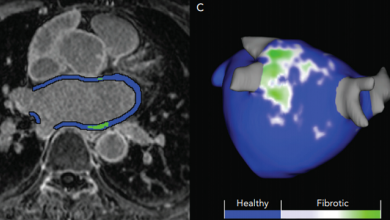Search results
Mapping AF Structural Substrates
Author(s):
Ahmed M Al-Kaisey
,
Ramanathan Parameswaran
,
Jonathan M Kalman
Added:
3 years ago
Article
Author(s):
Amir S Jadidi
,
Thomas Arentz
Added:
3 years ago
Adecade after its first description as ‘the electrophysiological substrate’ of atrial fibrillation,1 mapping complex fractionated atrial electrogram (CFAE) as an ablation target for atrial fibrillation (AF) remains highly controversial. Early high-density mapping studies of induced AF in humans revealed distinct mechanisms that underlie electrogram fractionation: collision areas of distinct…
View more
CMR and AF Management
Author(s):
Yan Zhao
,
Lilas Dagher
,
Chao Huang
,
et al
Added:
3 years ago
Article
Author(s):
Jean-Baptiste Gourraud
,
Jason G Andrade
,
Laurent Macle
,
et al
Added:
3 years ago
Atrial fibrillation (AF) is the most common sustained cardiac arrhythmia observed in clinical practice, occurring in approximately 2 % of the general population.1–3 A progressive increase in both the prevalence and incidence of AF has been demonstrated in recent years, defining AF as a major economic and public health issue.1
The identification of sites of AF initiation and/or maintenance within…
View more
Author(s):
Domenico G Della Rocca
,
Sanghamitra Mohanty
,
Chintan Trivedi
,
et al
Added:
3 years ago
AF is the most common sustained arrhythmia, and carries an increased risk of cardiovascular and cerebrovascular complications. The latest estimates on the prevalence of AF portray an alarming scenario, with a steep increase in the number of people developing AF and prediction that the number affected will more than double in the next 40 years.1 Among the strategies to restore and maintain sinus…
View more
Author(s):
Marius Andronache
,
Nikola Drca
,
Graziana Viola
Added:
3 years ago
AF is the most common sustained cardiac arrhythmia in clinical practice. It is associated with increased risk of stroke and heart failure (HF), and is a significant global health challenge.1 Catheter ablation procedures, which isolate the pulmonary veins (PV) from the left atrium and prevent AF initiation, are effective and safe treatment options, and have emerged as the preferred rhythm control…
View more
Atrial Myopathy Underlying AF
Author(s):
Harold Rivner
,
Raul D Mitrani
,
Jeffrey J Goldberger
Added:
3 years ago
Article
Drivers of Atrial Fibrillation
Author(s):
Ian Mann
,
Belinda Sandler
,
Nick WF Linton
,
et al
Added:
3 years ago
Article
Author(s):
Rakesh Latchamsetty
,
Fred Morady
Added:
3 years ago
Catheter ablation of AF has shown steady growth over the past two decades with a nearly 15 % annual increase in the US.1 This growth can be attributed in large part to four factors: an increase in operators and institutions performing the procedure;2 a steady rise in AF prevalence, which is predicted to reach 12 million in the US by 2030;3 a larger spectrum of AF patients with more complex atrial…
View more













